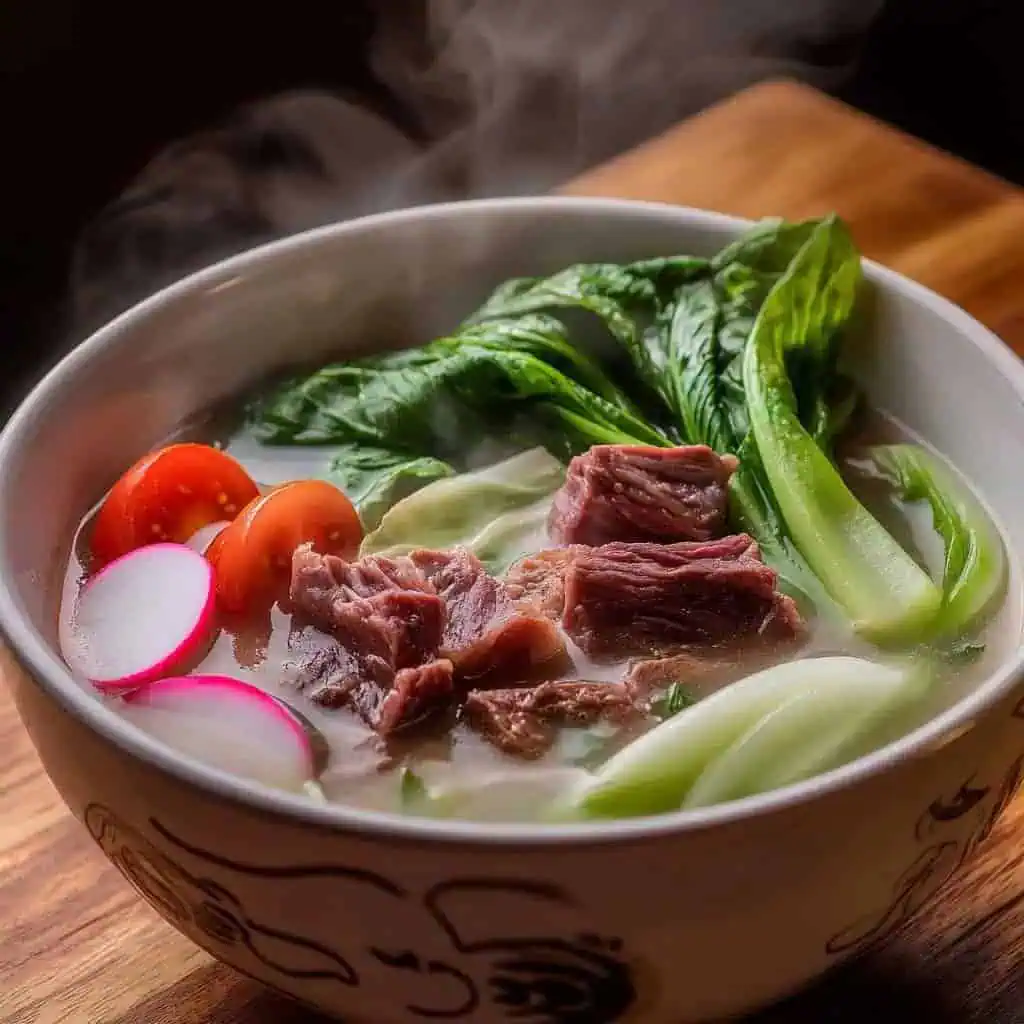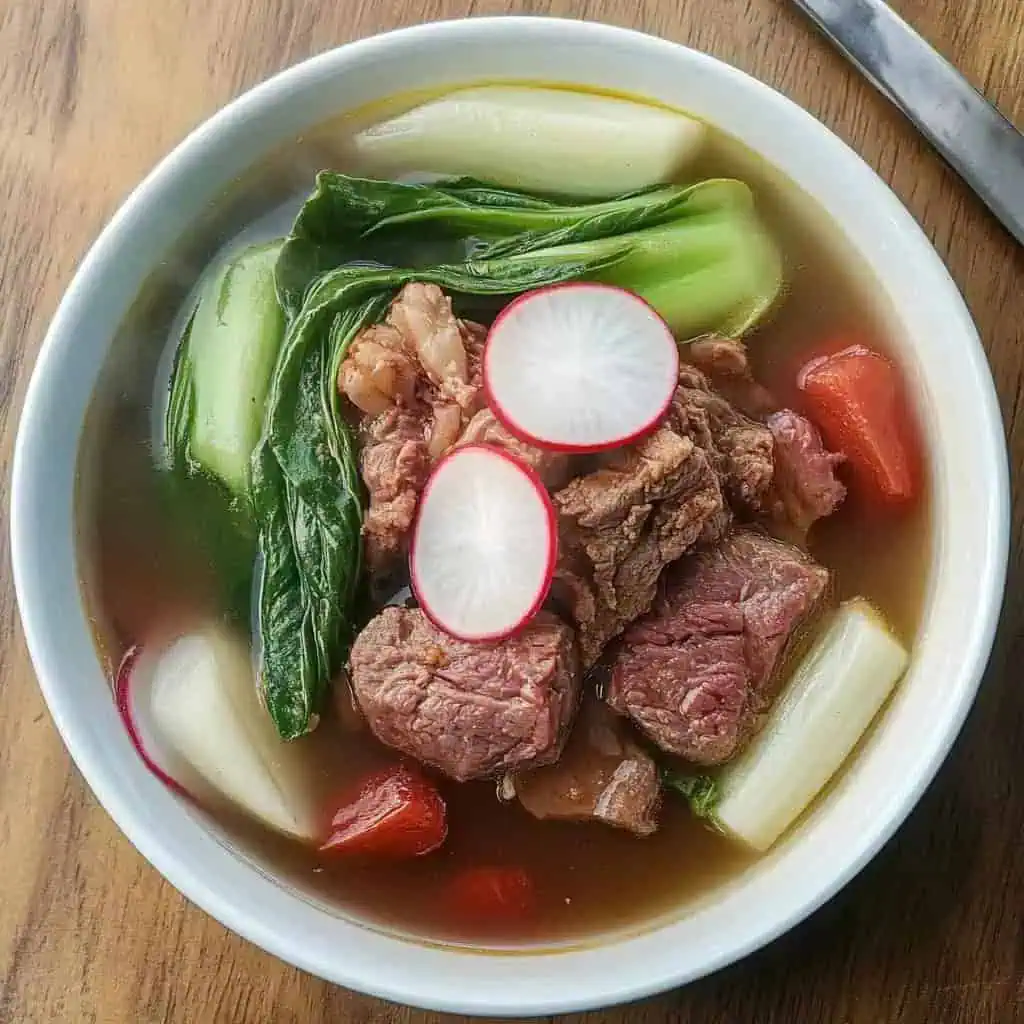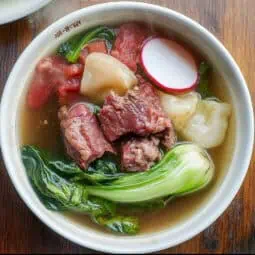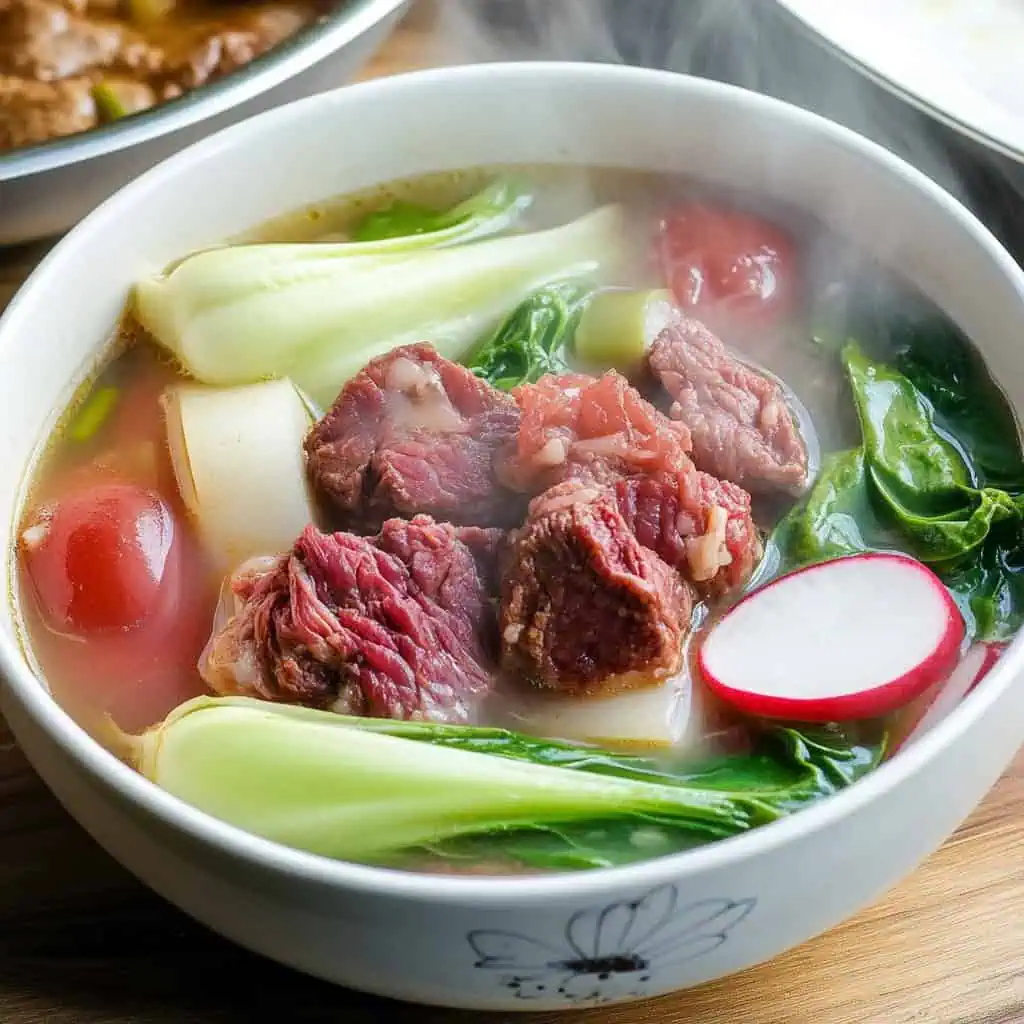You know how sometimes you stare at that can of corned beef in your pantry and think, "I want to do something different with this"? Well, that's exactly what happened to me.
I've always loved corned beef. It's my go-to comfort food for quick meals. But one rainy day, while craving both corned beef and sinigang (I know, weird combo, right?), I thought, "Why not combine them?"
This happy kitchen experiment turned into one of my favorite ways to cook corned beef. This Corned Beef Sinigang takes our beloved canned meat to a whole new level by swimming it in that addictive, tangy tamarind broth we all love. It's super easy to make, surprisingly delicious, and perfect for those days when you want something comforting but don't want to spend hours in the kitchen.
Jump to:

Why You'll Love This Recipe
- Ready in just 40 minutes – perfect for busy weeknight dinners
- Budget-friendly using pantry staples
- Combines familiar corned beef with traditional Filipino flavors
- Customizable with seasonal vegetables
- Comforting and satisfying, especially during cold weather
- Perfect balance of salty and sour flavors (may-asim na sabaw)
Ingredients
This recipe brings together the perfect balance of flavors and textures. The chunky corned beef provides a rich, savory base that pairs wonderfully with the sour tamarind soup mix. Onions and tomatoes create a fragrant foundation, while daikon adds a mild peppery crunch that absorbs the broth.
Bok choy brings freshness and vibrant color, added last to maintain its tender-crisp texture. Fish sauce deepens the overall umami without overpowering the dish's signature tang.
Every ingredient serves a purpose – creating a quick, balanced soup that tastes like it simmered for hours.

- 5 cups water
- 1 can (11.5 ounces) chunky corned beef
- ½ package (about .70 ounce) tamarind soup base mix
- 1 tablespoon fish sauce
- Salt to taste
- 1 small onion, peeled and quartered
- 2 Roma tomatoes, quartered
- 1 (6-inch) daikon radish, peeled and cut into 1-inch thickness
- 2 bunches bok choy, ends trimmed
Equipment
- Large soup pot: Essential for properly cooking the sinigang and allowing flavors to develop—a heavy-bottomed pot distributes heat evenly
- Sharp knife: For precisely cutting vegetables to ensure even cooking time
- Wooden spoon: Prevents scratching your pot and allows for gentle stirring to keep the corned beef chunks intact
- Measuring cups and spoons: Ensures recipe accuracy, especially for the tamarind mix
- Cutting board: Provides a stable surface for preparing vegetables
- Colander: For washing vegetables thoroughly before adding to the soup
- Ladle: For serving the soup without breaking up the corned beef chunks

How To Make
- Bring a large pot of water to a boil over medium heat with quartered onions and tomatoes.
- Once boiling, add the daikon radish slices and cook for 3 to 5 minutes until they become slightly tender but still have a bite.
- Pour in the tamarind soup base mix and stir until it completely dissolves in the broth.
- Add the trimmed bok choy and let it cook for just 1 minute until bright green.
- Gently add the chunky corned beef, breaking it into large pieces with a wooden spoon, and cook for 2 to 3 minutes until heated through.
- Season with fish sauce and salt to taste, being careful with the salt since corned beef is already salty.
- Let the soup rest for 5 minutes before serving to allow the flavors to fully develop.
- Serve the soup piping hot in bowls with steamed rice on the side.

Tips from Lola's Kitchen
- Use rice washing water (hugas bigas) instead of plain water for a more flavorful broth with added nutrients
- Add finger chilies for a pleasant spicy kick that enhances the overall flavor
- Break the corned beef very gently to maintain its chunky texture—this provides better mouthfeel
- Add the leafy vegetables at the very end of cooking to preserve their nutrients and vibrant color
- For extra depth of flavor, slightly toast the corned beef in the pot before adding liquid
- The soup tastes even better the next day after flavors have had time to meld together
- A squeeze of fresh calamansi juice just before serving brightens all the flavors
Substitutions
- Corned beef: Canned meat loaf, chunky beef, or even sardines in a pinch
- Bok choy: Kangkong (water spinach), regular pechay, or spinach work beautifully
- Daikon radish: Turnips, potatoes, or even taro root (gabi) for a thicker broth
- Tamarind mix: Fresh tamarind pulp (3-4 tablespoons boiled in 1 cup water, then strained) or kamias (bilimbi fruit)
- Fish sauce: Regular salt or light soy sauce, though the flavor profile will change slightly
- Tomatoes: If unavailable, add an extra teaspoon of tamarind mix for more sourness
Troubleshooting
- Soup too sour? Add a pinch of sugar or more water to balance the tartness
- Broth too salty? Add more vegetables or a splash of water, or serve with extra rice
- Corned beef falling apart? You may be stirring too much or cooking at too high a temperature—reduce heat and stir minimally
- Broth too thin? Simmer uncovered for 5-10 minutes longer to reduce, or add a small amount of corn starch slurry
- Vegetables too soft? Add them in stages based on cooking time—root vegetables first, leafy greens last
- Not sour enough? Add more tamarind mix or a squeeze of fresh calamansi or lemon juice
Storage & Reheating
- Refrigeration: Store in an airtight container for up to 3 days in the refrigerator
- Freezing: Not recommended as vegetables lose texture, but if necessary, freeze only the broth with meat
- Reheating: Warm slowly on the stovetop until it reaches a gentle simmer and internal temperature of 165°F (74°C)
- Best practice: If planning leftovers, reserve some uncooked bok choy to add fresh when reheating
- Meal prep tip: Prepare the broth base ahead of time and add fresh vegetables when reheating for a quick meal
- Flavor enhancement: Add a fresh squeeze of calamansi when reheating to revitalize the flavors

FAQ
Is this authentic Filipino sinigang?
This is a modern fusion version that uses canned corned beef instead of traditional meat cuts. While not strictly traditional, it captures the essence of sinigang's sour flavor profile with a convenient twist.
Can I make this ahead for a party?
Yes! Prepare the broth with meat and hard vegetables a day ahead, then add leafy greens just before serving. This actually improves the flavor as the broth has time to develop.
Why is my corned beef dissolving into the broth?
This typically happens when the corned beef is stirred too vigorously or added too early in the cooking process. Add it toward the end and stir gently to maintain chunks.
Can I use a slow cooker for this recipe?
Yes, but add the corned beef and leafy vegetables in the last 30 minutes of cooking to prevent them from breaking down too much.
How can I make this recipe healthier?
Use low-sodium corned beef, increase the vegetables, and reduce the amount of tamarind mix. You can also skim off any oil that rises to the surface.
Can I add other vegetables to this soup?
Absolutely! Traditional sinigang vegetables like string beans, eggplant, okra, and taro root work wonderfully in this recipe.
What's the best rice to serve with Corned Beef Sinigang?
Plain steamed jasmine rice is ideal as it absorbs the flavorful broth without competing with the tangy soup.
Why use corned beef instead of fresh meat?
Corned beef provides a convenient option that's already seasoned and doesn't require long cooking times to tenderize. It's perfect for quick meals while still delivering rich flavor.
Related
Looking for other recipes like this? Try these:

Corned Beef Sinigang
Equipment
- Large soup pot (kaldero) for cooking the sinigang
- Sharp knife (kutsilyo) for cutting vegetables
- Wooden spoon (sandok na kahoy) prevents scratching the pot and best for gentle stirring
- Measuring cups and spoons (Panukat) for accurate measurements
- Cutting board (Sangkalan) for preparing vegetables
- Colander (salaan) for washing vegetables
- Ladle - sandok for serving
Ingredients
For the Soup Base:
- 5 cups water tubig
- 1 can 11.5 ounces chunky corned beef (de-latang corned beef)
- ½ package tamarind soup base mix about .70 ounce (sampaloc mix)
- 1 tablespoon fish sauce patis
- Salt to taste asin
Vegetables (Gulay):
- 1 small onion peeled and quartered (sibuyas)
- 2 Roma tomatoes quartered (kamatis)
- 1 6- inch daikon radish peeled and cut into 1-inch thickness (labanos)
- 2 bunches bok choy ends trimmed (pechay)
Instructions
- Bring a large pot of water to a boil over medium heat with quartered onions and tomatoes. Once boiling, add the daikon radish slices and cook for 3 to 5 minutes until they become slightly tender but still have a bite.
- Pour in the tamarind soup base mix and stir until it completely dissolves in the broth.
- Add the trimmed bok choy and let it cook for just 1 minute until bright green.
- Gently add the chunky corned beef, breaking it into large pieces with a wooden spoon, and cook for 2 to 3 minutes until heated through.
- Season with fish sauce and salt to taste, being careful with the salt since corned beef is already salty.
- Serve the soup piping hot in bowls with steamed rice on the side. For extra flavor, prepare a small dish of fish sauce with calamansi as a dipping sauce.
- The entire cooking process takes about 25 minutes from start to finish, and you'll know it's ready when the vegetables are tender-crisp and the broth has a perfect balance of sour and savory flavors. Remember not to overcook the vegetables to maintain their texture and nutrients. Let the soup rest for 5 minutes before serving to allow the flavors to fully develop.
Tips from Lola's Kitchen
- Use rice washing (hugas bigas) instead of plain water for added flavor
- Add siling haba (finger chilies) for a spicy kick
- Break corned beef gently to maintain chunky texture
- Don't overcook vegetables to maintain nutrients and texture
- Let soup rest for 5 minutes before serving to allow flavors to meld
Nutrition
The Story Behind Corned Beef Sinigang
Growing up in a Filipino household, sinigang has always been our go-to comfort soup, traditionally made with pork, beef, or seafood in a sour tamarind broth. But as our culinary landscape evolved and busy schedules demanded quicker meals, innovative home cooks began experimenting with pantry staples, leading to the creation of this unique Corned Beef Sinigang.
This fusion dish perfectly captures the ingenuity of modern Filipino cooking. While purists might raise an eyebrow at using canned corned beef in sinigang, this adaptation actually makes perfect sense. The salty, rich flavor of corned beef naturally complements the sour tamarind broth, creating a balance that's surprisingly authentic to the Filipino palate. Plus, it's a practical solution for those craving sinigang but short on time – no need to wait hours for meat to tenderize!
The beauty of Corned Beef Sinigang lies in its accessibility. In recent years, as more Filipinos worldwide adapted traditional recipes to fit their busy lifestyles, this version gained popularity through social media and food blogs. It's become especially beloved among overseas Filipino workers and students who long for a taste of home but need quick, affordable solutions using readily available ingredients.
What makes this dish truly special is how it honors both innovation and tradition. While we've swapped the traditional meat for corned beef, we've kept the soul of sinigang intact – that perfect harmony of sour broth and tender vegetables that has comforted generations of Filipino families. Whether you're cooking this on a rainy day, fighting a cold, or simply craving something warm and satisfying, this modern take on sinigang proves that sometimes the best recipes come from thinking outside the traditional cooking pot.
Today, Corned Beef Sinigang stands as a testament to the evolving nature of Filipino cuisine – where convenience meets tradition, and necessity sparks delicious innovation. It's more than just a quick meal; it's a reflection of how modern Filipino families adapt and create new classics while keeping their culinary heritage alive.










Comments
No Comments